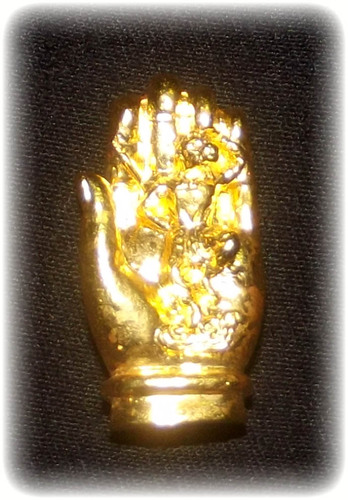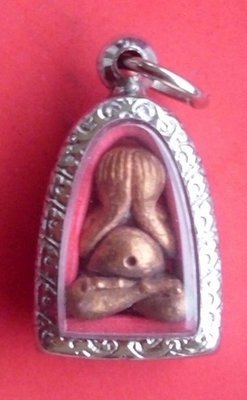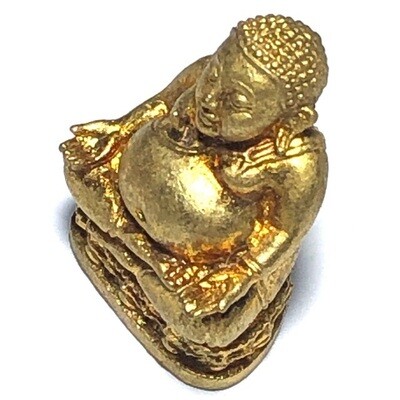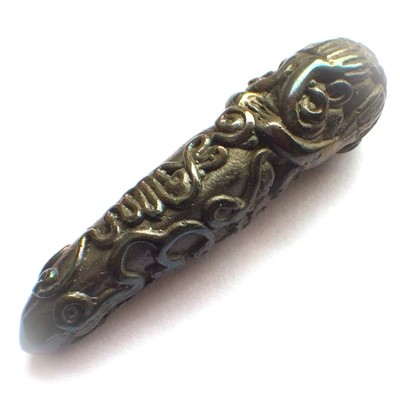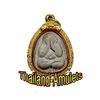

Thailand Amulets
Thai Buddhist and Magical amulets for Wealth, Health, Love and Happiness.
Vast Selection of Amulets
We have a vast selection of over 4000 different kinds of Sacred Amulets and Bucha Items, including Buddha Image, Loi Ongk statuettes, Buddhist Monk Coin Amulets, Takrut Charms, Nam Man Prai Oils, Mai Kroo Wands, Mitmor Ritual Knife, Lek Lai Kaya Siddhi Elemental Substance, Kumarn Tong, Gambling Amulets, Mae Nang Prai, Muan Sarn Sacred Powder Amulets, Palad Khik, Animist Charms, Necromantic Amulets, Buddhist, Animist, Brahman and Necromantic Amulets.
Fa Mer Pra Yulai 如来神掌 Arahant Praab Marn (Gammagarn with Code stamp #89) - Gold Plated Bronze - Pra Urai Buddha Hand holding Monkey God Subduing Mara Demons - LP Bpun Tammabalo 2553 BE
Hand of an Arahant Pra Yulai ( or in Chinese 'Yoo Lai Fuor' - 如来佛 or'Yoo Lai Fuor Ju - 如来佛祖). Heng Jia Monkey God in the palm of the hand of Pra Ulai (The Buddha) Subduer of the Mara Demons. A most Original, Powerful and Auspicious Buddhist Amulet from Luang Por Bpun Tammabalo of Wat Pah Tammayut (Wat Pah Ban Songk), in Roi Et.
This version is made from Sacred Bronze alchemical alloys with pure Gold Plating.This is the Gammagarn Special version, which differs by the lasered code number on the bottom front base. This example is number 89 from set Number 89.

The bottom of the front face of the amulet has the Thai Serial Code Number 89 engraved.
Amulets with code are always valued as the preferred collectors item for its rarity and rapid increase in Value as time pases, as well as for the richer content of Sacred Metals and Powders used).

The hand contains the image of the Monkey God, who was born of an egg made of stone that was bathed in sunlight for 500 Years on a Magic Mountain (Hua Guo San Mountain), and learned some very powerful Wicha, which, when he mastered them he called himself the most handsome monkey King and went on the rampage showing off the powers he had Mastered. He stole the Immortality drink and tried to become the Lord of all heaven. But he was to be taught a lesson by Buddha, in a Wager. Buddha betting him that he could not jump out of Buddha's hand. Should Monkey win, he demanded the Jade Emperor's job; should he lose, then he would be banished to Earth for centuries to learn some humility.

The rear face of the hand has the 5 Syllable Kata 'Na Mo Put Taa Ya', and a Dhamma Wheel. You may notice the presence of more than the usual eight spokes of the Dhamma wheel, which is in fact, not strange, for it is a falllacy that all Dhamma Wheels have eight spokes representing the Eight Fold Path;
We include the followiing quote from Buddhanet Website to give you a concise explanation of the various types of Dhamma Wheel design to be found throughout History;
"The wheel symbolises the Wheel of Buddhist Law, the endless cycle of birth and rebirth. The early Dharma Wheels followed the India tradition having many spokes as shown by this Dvaravati style from the 7th - 9th century.
Modern versions of Dharma Wheels often have four spokes, symbolizing the Four Jinas or the four 'moments' in the life of the Buddha; or with eight spokes, or octagonal, symbolizing the Noble Eightfold Path. The spokes sometimes extend beyond the circle, in points.
These wheels, represented in Indian art even before the period of King Asoka (272-232 B.C.E.), were generally placed on four lions, back to back, and facing the four cardinal points.
Deer are considered very gentle and non-violent animals. The Krishnasara or Ruru deer are considered especially compassionate. The fixated gaze of the two animals at the Dharma wheel symbolizes the captivating nature of the teachings and the active response of the audience who hears the sermon. The highest form of purification of the mental consciousness is achieved by hearing the ultimate teachings on selflessness. As Dharma is for the benefit of sentient beings, it is very significant to have the inclusion of the two deer listening to the teaching as part of this symbol. The two deer also represent samsara and the wheel represents Dharma, the cure of the problems of samsara. The fixated gaze of the two deer upon the wheel represents how they are inspired and encouraged by the enlightened one's four-fold skillful ways to attract beings to know the Dharma. The deer, like sentient beings, are wandering in the wilderness of wrong views and are tamed by the lion's roar as Manjushri namasangita says:
"The lion roar of selflessness vanquishes the evil wild animals of the heretics. By hearing the lion's roar, they are frightened and tamed.
Some of the above data was found and borrowed for spreading understanding of the Dhamma, from the following website;
Symbolism of the Dharma Wheel Buck and Doe - http://www.sakya.com.au/clearmind/95/dharmawheelbuckdoe/
Buddha tricked him into thinking he had found the five Pillars of Wisdom and got past the Buddha. But then he was to find out that he was not any further than where he started, and that the five pillars he saw, were truly the five fingers of the Buddha, whose hand he was standing. There are many legends, some of which do not cincide, but the general moral of the legend is that a Heng Jia Monkey God was initially very naughty and arrogant, but through learning from his wrong actions and also punishments he recieved, he finally became realized and a good servant of the Dhamma, and the Destroyer of Demons.
Monkey flew on clouds to the end of the universe, where he saw five pink pillars, which he took to be the end of the world. On the middle pillar he wrote "The Great Sage Equal of Heaven reached this place", to prove beyond any doubt he had reached this spot. Figuring it was a long trip back, and being the irrepressible individual he was, he also urinated at the base of the first pillar. Then he returned to face the Buddha. To his shock, the Buddha informed him he had never left Buddha's hand - and to prove it, showed Monkey the writing on his middle finger and the distinctive smell at the bottom of his smallest digit. Monkey tried to renege on the bet, but before he could escape, Buddha pushed him out of the Gate of Heaven, then Buddha changed his five fingers into the five elements (metal, wood, water, fire and earth). They became the five-peaked mountain under which Monkey was trapped, leaving only his head and hands exposed.

After 500 years he was granted a chance to redeem himself by accompanying holy man Tripitaka on a journey to the West as his companion and guard. In order to keep him under control, a band of metal was put on his head that Tripitaka could cause to tighten by muttering a chant - while this couldn't kill the indestructible chimp, it would cause him extreme pain.
We love this amulet because of its purely Buddhist influence and potent strength to keep away all 'abamongkol' and 'amanut' (inauspicious events and monstrous beings). The Hand of Pra Urai is protagonized in the legend of Heng Jia, the Monkey God who tried to pass the had in competition. In the end, he thought he had arrived past the Hand and reached the 5 pillars of Wisdom, but he was then disapointed to fiind that he was standing on the palm of the hand of Pra Urai, and that the 5 pillars were the fingers of Urai's Hand. Heng Jia was then punished by being buried under a mountain for 500 years.
999 of these were made in the 'Dtraimas 53' edition.

The amulet was made in various metals depending on 'Run' (edition). Nuea Tong Fa Badtr (almsbowl lid), Solid Silver,Bronze with Gold Plating, Albaca, and Nava Gae Ngern (Nava Loha with extra quantity of pure silver smelted into it). This version is in Neua Loha Chup Tong Kam (Sacred Bronze with Gold Plated covering). It has sacred powder and relics in the base.
Luang Phu Bpun is a very humble, silent, still, and well practiced master famed for his Hun Payont Ghost Soldier amulet that have become reference standard in the 'Dtamra Hun Payon', and entered the annals of History as one of the most important and prefferred Hun Payont of all Masters.
Thailand Amulets' owner, Ajarn Spencer Littlewood, is a Family relative of Luang Phu Bpun, and during Ajarn Spencer's time as a Buddhist Monk, he was able to be lucky enough to perform a central house pillar blessing in Duo with Luang Phu Bpun, learning the Wicha for Blessing and Empowering the Foundations of a Newly Built House. Ajarn Spencer's experience and intimacy with this Great Master Guru Monk, was enough for Ajarn Spencer to notice easily the true power and Wicha of this Experienced and Humble old Master Guru Monk of Tudong Forest Tradition. For this reason, that we are sure of his abilities, Luang Phu Bpun is one of our preferred and recommended Masters for Powerful Amulets.

Above; Luang Phu Bpun (Left) presides over the empowerment of the Middle Pillar Blessings for the construction of a new house. along with Bhikkhu Chinawangso to assist (Ajarn Spencer Littlewood as he was Ordained Bhikkhu).
Because this Wicha by Luang Phu Bpun is so inimtable and his personal creation, we include some research links for you to read to increase your understandiing of the possible permutations of apllied us and symbolic meanings contained within this most original amulet that carries the power to prevent evil from approaching and encompasses the whole Universe without borders. No Demon can get past the protective hand of the Arahant, subduing Mara.

Comes in Original Box from Temple - Can be Encased if Desired.
Useful Research Info Sources of Interest;
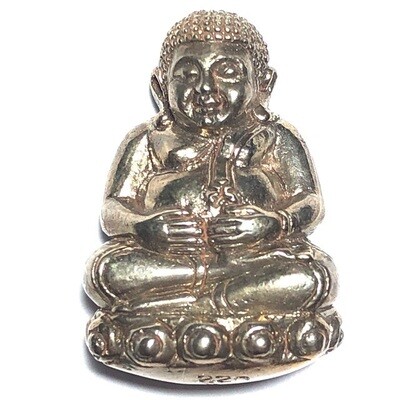
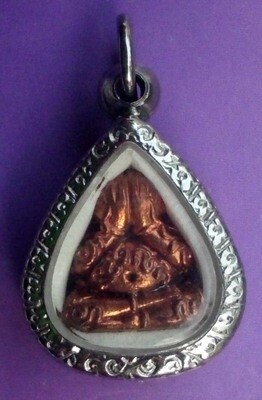

Contact Us
Follow Us on Youtube
About Us
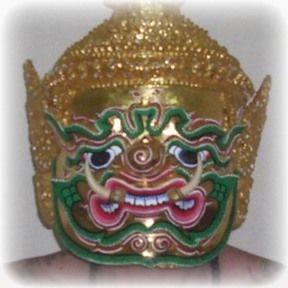
Ajarn Spencer
Proprietor
Thailand Amulets is owned and Administrated by Thai Occult and Amulet expert, Ajarn Spencer Littlewood who guarantees only authentic blessed amulets, and a free gift with every order, as well as his safe delivery or money back guarantee. https://facebook.com/ajarnspencer
